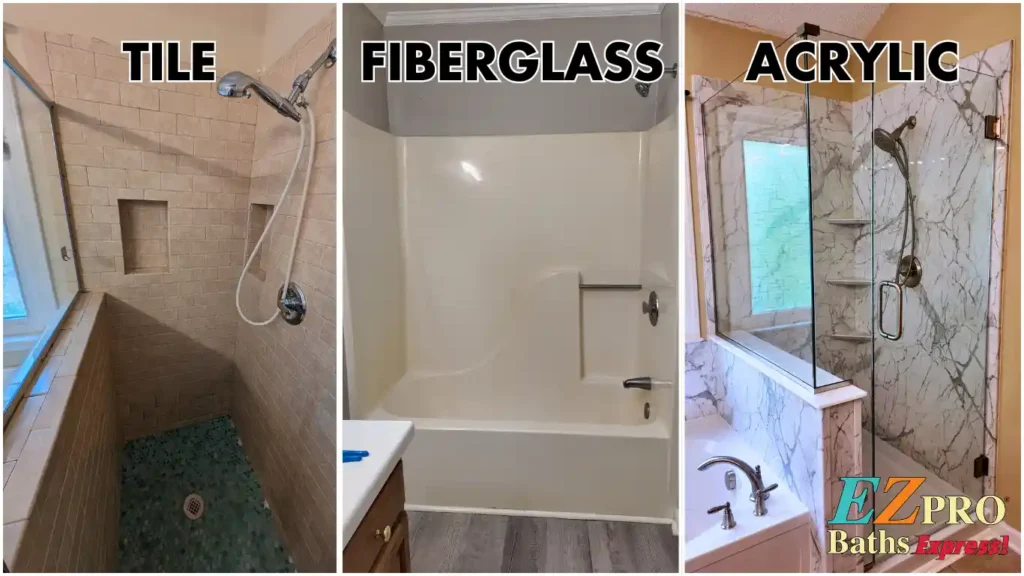Cleaning and maintaining your tub or shower can make it last for much longer before needing a replacement.
But what should you use to clean your tub or shower? How often should you clean it? We’ll answer those questions and include our tips for an easy, worry-free shower or tub cleaning experience.
Find out What Material Your Tub or Shower is Made of
Before we get into the nitty gritty of cleaning your tub or shower, you should figure out what material your tub or shower walls and pan are made of. Also consider that sometimes the pan will be a different material than the walls. For example, you might have tile shower walls with a fiberglass pan.
The materials that your shower is made from is going to change what kind of products you can use to clean your tub or shower and how hard it’s going to be to keep your shower clean. There are many different materials tubs and showers can be made from, but let’s touch on the three most common ones:

Fiberglass
The most common tub or shower material, fiberglass’s affordability is one of the biggest reasons you can find it in most homes. It’s cheap and light, but the tradeoff is you get a less durable product.
Fiberglass is soft, so it cannot withstand abrasive cleaning materials. These can scratch the gel coat, leading to leaks and discoloration. Instead, you should use vinegar, water, baking soda and a soft cloth to keep it clean. Most people don’t realize that fiberglass must be treated with care and will use abrasive cleaners with it, causing it to deteriorate and age quickly.
Most fiberglass tubs last around 15 years if well-maintained. If you aren’t cleaning your fiberglass tub or shower regularly and are using harsh chemicals when you do clean it, the lifespan of your fiberglass tub or shower will be closer to 10 years.
Tile
Tile showers look great, but they are the hardest of the three listed here to clean and maintain. Tile grout is porous and will trap moisture which becomes a breeding ground for mold, mildew, and bacteria. Cleaning those spaces is difficult too as you need to scrub between the grout to get at any mold that has grown where moisture has been trapped.
A smooth, continuous, non-porous surface is going to be the easiest to clean. Tile also has to be installed correctly by a trusted installer or it will be prone to leaking.
Acrylic
Acrylic tubs and showers are by far the easiest material to clean due to silver ion technology, which helps prevent mold, mildew, and bacteria. While you must be selective with what products you use to clean an acrylic tub or shower, it’s a much more durable material when compared to fiberglass. Acrylic will look as good as the day it was installed for many years with proper maintenance
At EZPro Baths Express we only install virgin acrylic tubs and showers. We’re so confident in our acrylic’s durability that we back it with a 20-year labor warranty and a lifetime warranty against cracking, discoloration, and fading.
Our acrylic shower walls are also available in all sorts of patterns and colors. We have patterns that mimic the look of marble or tile without costing a fortune. We have simulated tile wall patterns that look like tile but are just one continuous panel. We also have laser etched tiles that are completely flush with the wall and whose “grout” lines can have different colors to meet your design needs.
We offer acrylic shower walls in a variety of patterns and colors, including ones that replicate the elegance of marble or tile at an affordable price. Our simulated tile wall patterns and laser etched tiles look like tile, but with the cleaning convenience of a single, continuous panel.

What Should I Use to Clean My Tub or Shower?
For cleaning a fiberglass or tile tub or shower, use two parts white vinegar (warm vinegar is better – heat it up in the microwave!) and one part Dawn dish soap. Put that mixture into a spray bottle and spray down your shower. Leave for 20-30 minutes and return to scrub it down with a scratch-free sponge or microfiber cloth. Rinse thoroughly after cleaning.
For acrylic, you can use the same method for an extra clean, but all you need to do is scrub it with mild soap and water with a soft washcloth.
How Often Should I Clean My Tub or Shower?
This is going to differ from shower to shower depending on the number of times someone uses the tub or shower and other aspects. Generally, we recommend using the two-part vinegar and one-part Dawn dish soap method mentioned above about once every other month.
Here are some factors that might affect the frequency you’ll want to clean your tub or shower:
- You have hard water
- You have flat surfaces that hold standing water after each use
- The tub or shower gets a lot of uses
- You don’t have a vent fan in the bathroom
Why is my Shower Pink, Yellow, Orange or Black?
All the mold and bacteria listed below thrive in damp environments like bathrooms. As the dampest room in the house bathrooms are especially prone to these molds, mildews, and bacteria.
If you’re noticing any of these colors on the surface of your tub or shower, you should be cleaning your tub or shower more often. Please note that there are thousands of mold species and not one color is indicative of one kind of mold or bacteria. The mold and bacteria listed below are the most common types based on that color.
Pink anywhere on the surface of a shower is typically a sign of bacteria called Serratia marcescens. It thrives in a warm, moist environment like a shower or sink.
Orange is typically a sign of the same bacteria or mineral or iron deposits from hard water.
Orange or pink, while not good for the longevity shower, is generally not harmful to humans (other than having to suffer looking at it).
A Yellow color on your tub or shower is a mold called Aspergillus. It is harmful to humans and can cause respiratory problems and allergic reactions in some.
Black in your shower is either mildew or the infamous “black mold” called Stachybotrys chartarum that should be cleaned up as soon as possible as it’s dangerous to humans. Telling apart mildew and black mold is not easy and we recommend looking up a guide online if you’re unsure whether you have common mildew or dangerous black mold. Mildew is very common in the bathroom and usually won’t bother humans too much. It does look gross though and is easy to clean if you stay on top of it.
Our acrylic is mold, mildew, and bacteria resistant thanks to silver ion technology.
How to Deep Clean Your Tub or Shower
If you’ve stumbled on this blog, odds are good that you let the problem become bigger than just normal, everyday cleaning. If you’re seeing any of the colors listed above, it’s time to do a deep clean.
Start with the basics – a simple two-parts vinegar and one-part dish soap combination to see if that does the trick first. If it doesn’t, use a half-cup of Clorox bleach per gallon of water as a disinfectant.
Once you’ve deep cleaned and removed any of the colors listed above be sure to deep clean it again within the next week to ensure any mold or bacteria that has re-grown isn’t allowed to spread again.
How to Keep Your Shower Clean
There are several ways you can keep your shower clean between uses that will make cleaning it much easier and won’t make you have to do it as often.
Avoid placing bar soap on shower shelves. When bar soap gets wet, it leaves and leaks soap scum wherever it sits. If you prefer to use bar soap over liquid soaps, put it on a shower caddy shelf instead of on a tub or shower shelf.
Rinse your shower walls after showering, to ensure you aren’t leaving soap residue, dirt, or other residue on the walls.
Keep the shower or tub dry between showers, which means airing the shower out and avoiding water holding areas. Leave the shower curtain open and run your bathroom fan an extra 15 minutes.
After you get out of the shower, come back 15 minutes later. Take notice of what areas are still holding water in your shower or tub. Those areas are going to be problem areas in the future and will likely develop mold at some point.
Remove any unused shampoo and conditioner bottles that trap moisture under them. Let’s be honest you have a couple of empty shampoo bottles you’re hoarding in your shower right now that came to mind.
Place your shower curtains as high as possible to avoid water pooling around curtains laying on the shower floor. Those creases and nooks and crannies are perfect breeding grounds for mold, mildew, and bacteria. Shake that water off your shower curtains after each use too!
When you’re cleaning your shower, pay attention to what is making it dirty. Is it soap scum? Or hard water spots? Mold from standing water?
Run your bathroom fan for 15 minutes after you’ve finished showering to ensure all the moisture and humidity is filtered out of the bathroom.
Keeping a Glass Shower Clean
Use the same vinegar-dish soap mixture as above with some additional caveats. You should squeegee shower glass after each use to avoid hard water stains and smudges.
You could apply RainX on your glass panels regularly to make your glass hydrophobic, making cleaning much easier and less frequent.
What Cleaners Should I Avoid?
Avoid abrasive cleaners at all costs as they can greatly damage the finish on your tub or shower material which will make cleaning in the future even more troublesome. There is no need to use abrasive cleaners as long as you’re cleaning your shower regularly, keeping your drain clear of hair and debris, and not allowing mold growth. In extreme cases where the cleaners listed above do not work, use a Chore Boy or a 3M Sponge Pad.
Here are some abrasive cleaners you should avoid:
- Original Clean Shower
- Clean Shower for Plastic Showers & Glass
- Soft Scrub
- Dow Disinfectant Cleaner
- Dow Scrubbing Bubbles
- Scrub-Free
- Lysol disinfectant cleaner
- Acetone
- Lestoil
- Ammonia
- Fingernail polish remover
- Aerosol cleaners
- Scouring pads
How to Clean or Unclog my Drain
Purchase a drain snake to grab hair and other scum that has already made its way down your drain. Using a physical element like a drain snake will allow you to avoid the use of harsh chemicals. In extreme cases where both a snake and drain unclogging chemicals are necessary, starting with a drain snake will make your drain cleaning solution go the extra mile.
If you must use a more extreme drain cleaning solution beyond just snaking the drain, liquid drain cleaners are recommended over powders or crystal. When using liquid drain cleaning agents, bail the standing water or give it time to drain and remove the drain plug. Always use a funnel to prevent spills and apply the chemicals directly down the drain. Make sure chemicals do not come into contact with the surface of the tub or shower as those abrasive chemicals can deteriorate the finish on the material. Go slowly when pouring liquid drain cleaners through the funnel and into the drain so the cleaner doesn’t overflow onto the surface of the tub.
How to Keep My Drain Unclogged
Purchase a cheap hair drain catcher to avoid hair and other scum from going into your drain. Clean the hair catcher after every few uses to ensure all the dirty water is draining properly.
Choose Acrylic and Get a Beautiful Look with Hassle-Free Cleaning
Acrylic combines style, durability, and cleanliness that tile and fiberglass don’t hold a candle to.
If you’re looking for a stylish, easy-to-clean acrylic shower, fill out the form below and we’ll give you a call to schedule a free in-home design consultation to start working with you on your new tub or shower!
Schedule Your FREE in-Home Consultation
24 Bathroom Remodeling Trends for 2025
Bathrooms are undergoing transformation in 2025. Homeowners are prioritizing timeless...
Read MoreIs Your Tub Fiberglass or Acrylic?
Your bathtub isn’t just a functional part of your bathroom—it’s...
Read MoreCommon Types of Bathtub and Shower Damage (And How to Avoid Them)
Bathrooms endure a lot of wear over time, and tub...
Read More




